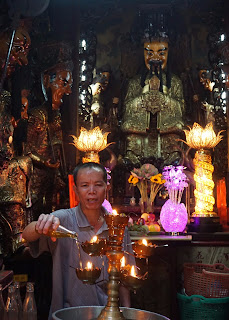January 19, 2017
Today we are back at Angkor
to see more of the temples. To get around this vast city, we hired a Tuk Tuk and driver.
This is a motorcycle taxi, ubiquitous in Asia.
Our first stop is Thommanom,
just outside the east gate of Angkor Thom.
It was built in the 1100’s when the Khmer were still Hindu. It is small but seems well preserved for its
age. Across the road we visit Chau Say
Tevoda. It is of the same age and
design but doesn’t seem to have been reassembled as well.
Angkor is a land of temples,
hundreds, and I am already thinking I am “templed” out. Fortunately our next stop is at Ta
Prohm. This large, relatively flat
temple is still mostly in the condition it was found. After Angkor was abandoned the surrounding hot steamy jungle repossessed it. You can’t believe the
size of the trees that have grown up, through, and around the walls of this
temple. They add a mysterious aura to the scene but are vastly destructive.
Left to nature, the roots will slowly and inexorably topple every
stone. Authorities need to remove the
trees to stabilize the structures, to the dismay of tourists like me. The temple scenery is very cool but for the
onslaught of Chinese tourists wanting their photo in front of every
vine-covered wall.
Our next stop is across the
street at Banteay Kdei. This is a Buddhist temple monastery with lots of
towers, that strangely has a hall decorated with dancing girls behind it.
Apparently being a monk in those days wasn’t so bad.
We finished our morning at
Srah Srang. Angkorites loved to dig
holes. If it wasn’t moats around their temples, it is a reservoir like this
one. They either did it for water storage
or drainage control, or possible recreation.
This one has a nice stage on one end with statues of lions and serpents.
After lunch we visit the
premier tourist draw of Cambodia, Angkor Wat. The name means Capital (or City)
Temple. Appropriate since it is the
largest religious monument in the world. It is almost a mile square and
completely surrounded by a moat. It was built in the early 1100’s, almost 100
years before Angkor Thom and Bayon.
We enter crossing a long
causeway to the island and then through a temple-like entrance monument. Past the gate there is a long avenue to the
center complex. On either side of the path are reflecting pools. We are lucky. Today we have clear skies with no rain and little wind. So I can take the classic photo of Angkor
Wat with blue sky in the background and a perfect reflection in the pond.
The core of Angkor Wat
consists of three concentric rectangular galleries. The central one has four corner towers with a 210-foot central
tower. The gallery walls are decorated
with a continuous bas-relief sculpture telling some linear tales. They are in superb condition probably
because they are covered and coated with lacquer. With the large moat, the destructive vines were also kept at
bay. In one of the inner courtyards, a
couple of monks are selling fortunes.
The Bakan or Inner Gallery is
only accessible by a set of steep stairs and visitation is limited. We wait in line almost a half-hour for our
turn. It is anti-climatic but does give
us a good view of the surroundings.
Surprisingly, the courtyard looks like it must have been filled with
water to represent the ocean.
We exit the backside, walking
past more friezes to leave the way we came in.
We take our Tuk Tuks on a very dusty ride back to the bus. It has been a
long, muggy, hot, but interesting day.
Unfortunately, our guide is not finished with us. From Angkor, we drive forty minutes down the
Siem Reap River to a dock. There we
load onto a boat that carries us down river till it empties into Tonle Sap
Lake.
Tonle is a major river that
flows into the Mekong. Here it passes
through a large geologic depression where it spreads out into the largest lake
in Southeast Asia. It expands
dramatically during the wet season.
The lake is a major source of fish.
Fisherman live along the shore and in the water on stilts like we have
seen in the Mekong and Halong Bay. There is even a floating church. While interesting to see the lake and the
sunset, we don’t really need to see another floating slum.
Back in Siem Reap, we still are not done to my
dismay. I am not feeling well, maybe allergies,
maybe the heat, or likely both. We stop
at a couple markets before we finally make it back to the hotel at 7:30. I spread out on the bed under the
air-conditioning.



















































